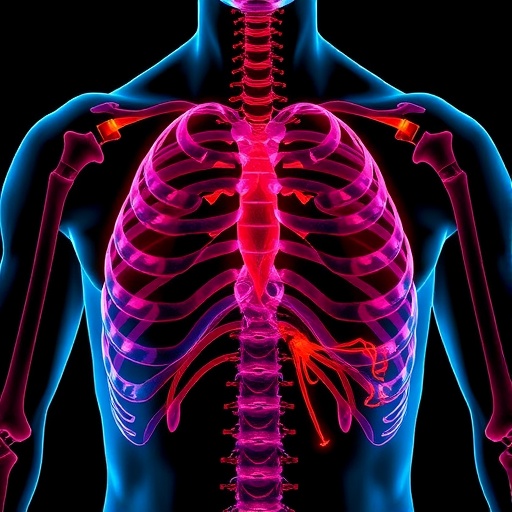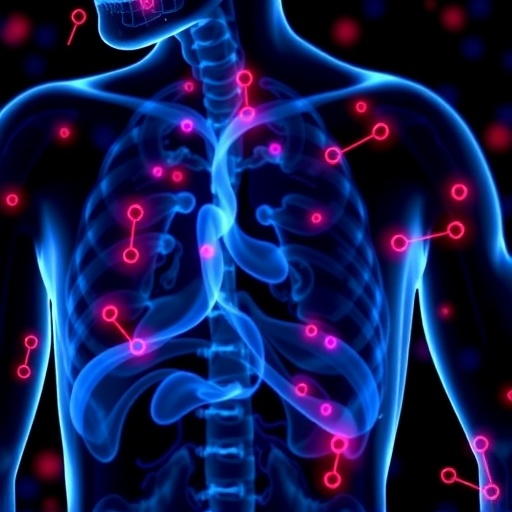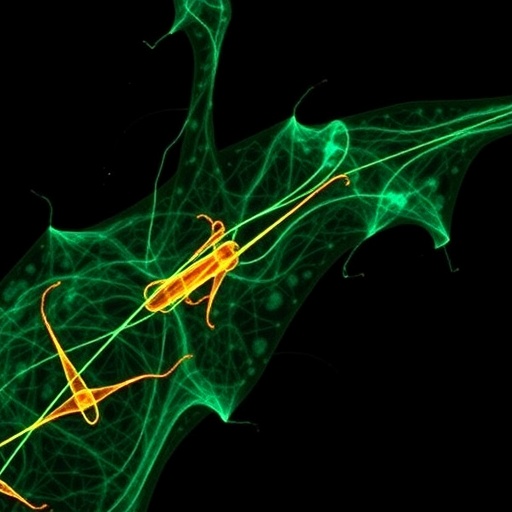In a groundbreaking stride towards advancing forensic science, researchers have unveiled a novel application of proteomics that could revolutionize the way post-mortem investigations are conducted. The recent study, spearheaded by Galante, Capitanio, Moriggi, and colleagues, delves deep into the enigmatic phenomenon of vital reaction in human ribs after death, offering fresh insights that meld cutting-edge molecular biology with forensic pathology. This pioneering work could unlock unprecedented pathways to determine time and circumstances of death, a challenge that has long perplexed forensic experts worldwide.
Vital reaction, often a contentious concept in forensic pathology, refers to the biological responses elicited by an organism’s tissues while still alive or during the peri-mortem period. Discerning whether injuries occurred before or after death can be the determinant in criminal investigations, influencing verdicts and, consequently, delivering justice. However, current methodologies, often reliant on histological or macroscopic examinations, struggle to definitively confirm these vital responses, especially in skeletal tissues, which complicate forensic interpretation due to their mineralized nature. The approach taken by Galante and team harnesses the power of proteomics—the large-scale study of proteins—to dissect these subtleties at a molecular level.
Proteomics, the high-throughput analytical profiling of the full complement of proteins expressed in a cell or tissue, provides a dynamic window into biological processes. Since proteins are the main executors of cellular function and respond rapidly to physiological changes, their patterns serve as real-time signatures of cellular activities including inflammation, repair, and cell death. By applying proteomic analyses to human rib specimens, the researchers aimed to decode the molecular imprints left by vital reactions, distinguishing them from post-mortem changes. This represents a crucial advancement because bone, heavily mineralized and complex in composition, has traditionally resisted detailed molecular scrutiny.
.adsslot_Wn6L3kEKZp{ width:728px !important; height:90px !important; }
@media (max-width:1199px) { .adsslot_Wn6L3kEKZp{ width:468px !important; height:60px !important; } }
@media (max-width:767px) { .adsslot_Wn6L3kEKZp{ width:320px !important; height:50px !important; } }
ADVERTISEMENT
The study deployed state-of-the-art mass spectrometry techniques to quantify and identify proteins extracted from rib samples subjected to controlled post-mortem timings. The precise detection of protein markers associated with inflammation and cellular stress responses affirmed that certain proteomic fingerprints are indicative of vital reactions—biological processes occurring prior to death. These molecular signals persisted distinctively compared to those arising strictly from degradation after death, providing an unprecedented molecular toolkit for forensic investigation.
One of the key revelations was the identification of specific inflammatory proteins that serve as a hallmark of vital reactions within the bone matrix. These proteins, which play pivotal roles in immune response and tissue repair, demonstrated altered expression levels in samples representing injuries sustained during life. This molecular evidence offers forensic pathologists powerful markers to map injury timelines with far greater accuracy than previous histological methods, bridging a critical gap in forensic diagnostics.
Moreover, the research addressed the temporal dynamics of protein expression degradation after death, enabling the team to discriminate between proteomic changes attributable to ante-mortem trauma versus post-mortem decay. Understanding these temporal profiles is essential for pinpointing the post-mortem interval—estimating time elapsed since death—which is often a cornerstone in forensic reconstruction. The proteomic signatures mapped in this study provide a new molecular chronometer for post-mortem investigations.
The implications of this research extend beyond academic curiosity. In practical forensic settings, law enforcement and medical examiners often face the daunting challenge of interpreting decomposed or skeletal remains where traditional methods flounder. This proteomics approach, focusing on rib bone due to its accessibility and robustness, offers a pragmatic avenue for routine forensic analysis. By establishing a molecular baseline of vital reactions, forensic teams could significantly enhance the evidentiary robustness of their findings.
Technically, the application of sophisticated mass spectrometry paired with rigorous bioinformatics allowed for comprehensive profiling of hundreds of proteins simultaneously. This multidimensional data was then subjected to comparative analyses that isolated vital reaction markers from proteomic “noise” caused by environmental contamination or non-specific decay processes. The meticulous methodology underscored the study’s reliability and opened avenues for future refinement and validation across diverse forensic contexts.
Additionally, the choice of ribs as the skeletal focus was strategic; ribs are less likely to be directly injured in many forensic scenarios but can reflect systemic biological responses. By examining rib proteome alterations, the researchers could infer systemic inflammatory and repair processes triggered by trauma, thus extending the reach of proteomics beyond localized injury assessment. This systemic perspective may also aid in understanding complex trauma cases involving multiple injuries.
The pioneering nature of this forensic proteomic investigation also raises prospects for its integration with other molecular techniques, including DNA and metabolomic profiling, offering a multiomics perspective on post-mortem tissue changes. Such integrative strategies promise to improve the precision and scope of forensic assessments, potentially transforming cold cases or ambiguous deaths into well-substantiated legal evidence.
Societally, the adoption of proteomics in forensic medicine could fundamentally enhance justice mechanisms by providing incontrovertible biochemical evidence of injuries and cause of death. This would be particularly transformative in cases involving covert violence or medical negligence, where subtle or disputed injuries require molecular validation. The non-invasive sampling and high sensitivity of proteomic assays suggest this methodology could be widely implemented without compromising forensic chain-of-custody protocols.
This research also marks a significant milestone in forensic science’s ongoing transition from qualitative, subjective evaluations toward quantitative, objective molecular diagnostics. The capacity to translate biochemical data into legally defensible conclusions aligns perfectly with contemporary demands for evidence-based forensic testimony. Furthermore, proteomics’ ability to capture snapshots of biological processes in otherwise inert tissues underscores its unique potential in forensic investigations.
In conclusion, the study by Galante et al. heralds a new era of forensic applications enabled by proteomics, demonstrating that the rib bone carries definable molecular marks of vital reactions. This method not only elucidates the time and nature of injuries more accurately than ever but also establishes a foundation for future research into other skeletal sites and forensic challenges. As the forensic community seeks tools that offer both precision and reliability, their research represents a beacon of innovation.
The forensic application of proteomics, as laid out in this study, transcends traditional boundaries of pathology and molecular biology. It integrates advanced analytical technology with forensic imperatives, setting the stage for more profound insights into human death and trauma. This development could redefine forensic protocols globally, making the invisible protein world a cornerstone of justice.
As forensic science embraces these high-resolution molecular tools, we can anticipate a more nuanced understanding of death’s complexities, ensuring that biological truth is uncovered at the microscopic level. This proteomic breakthrough, focusing on human ribs, thus symbolizes not only a scientific advance but a vital societal contribution to truth and justice.
Subject of Research: Proteomic analysis of human ribs for forensic investigation of vital reaction post-mortem.
Article Title: Post-mortem forensic application of proteomics on human ribs: Investigating the phenomenon of vital reaction.
Article References:
Galante, N., Capitanio, D., Moriggi, M. et al. Post-mortem forensic application of proteomics on human ribs: Investigating the phenomenon of vital reaction. Int J Legal Med (2025). https://doi.org/10.1007/s00414-025-03519-w
Image Credits: AI Generated
Tags: advanced forensic methodologieschallenges in forensic interpretationdetermining time of deathforensic pathology innovationsGalante research study findingshuman ribs vital reactionsmolecular biology in forensicspost-mortem investigations techniquesprotein analysis in criminal investigationsproteomics in forensic scienceskeletal tissue analysisvital reaction concept in pathology





